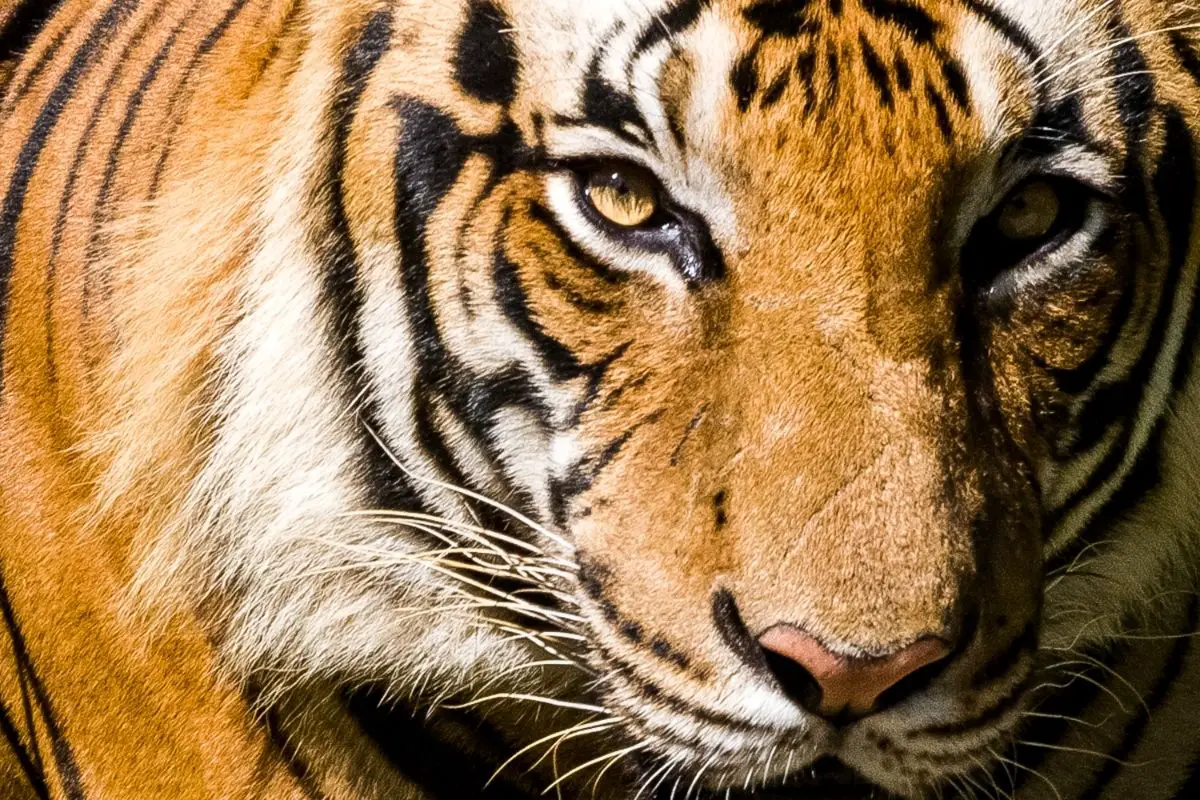The Indochinese tiger (Panthera tigris tigris) is one of the 6 subspecies of tiger. They are commonly found in regions of Southeast Asia.
These magnificent beasts can be found roaming the jungles of Thailand, Laos and Vietnam.

Indochinese tigers are one of the smaller species of tiger found around the world and mainly hunt Samba deer, wild boar or banteng cows.
However, they have also been known to feed upon even larger animals, such as Asian elephants and pangolins.
If you want to know all there is known about this breed of tiger, then you have come to the right place.
In this article, we will cover the basic characteristics of this species, as well as their feeding habits and how endangered they are.
Defining Characteristics Of Indochinese Tigers
The Indochinese tiger is generally significantly smaller in size when compared to its relatives, the Bengal or Siberian tiger.
Like most tigers, they are characterized by their distinctive orange fur that is broken up with black stripes.
However, the stripes on an Indochinese tiger are more narrow than those seen on other species, and their overall coloration is slightly darker as well.
Dimensions
A fully grown male Indochinese tiger can be anywhere between 8.4 and 9.4ft in length from head to tail.
The females of the species are generally a bit smaller and range between 7.5 and 8.4ft in length.
Male tigers can weigh as much as 430lbs, while the females generally have an upper weight of 290lbs.
Hunting Habits
These tigers are solitary predators, and it is very rare to see two of them together unless it is a mother with cubs or a mating pair.
Like other members of the Panthera genus, these cats are primarily nocturnal and prefer to hunt for food at night.
As we said earlier, they mainly feed upon ungulates such as deer, cattle and wild boar.
They have been known to take down larger mammals as well, such as Asian elephants.
Much like other tigers, the Indochinese subspecies stalks its prey, using the natural camouflage provided by its stripes, until it is ready to charge.
They have retractable claws that can be used for climbing small trees, but are primarily used for ripping out the throat of their prey.
Thanks to their incredible eyesight, these big cats can see and hunt in the dark without issue.
Their tongues have backward facing spines, called papillae, that enable them to lick a carcass down to the bone while feeding.
When charging their prey, Indochinese tigers are capable of reaching speeds of up to 60mph over short distances.
Lifecycle
In the wild, Indochinese tigers can live anywhere between 15 and 25 years.
These big cats are capable of mating all year round, although scientists suspect that their main breeding season is somewhere between the months of November and April.
The gestation period for this species is only 3 ½ months, after which the female tiger will give birth to a litter of 3 to 7 cubs.
Due to their short gestation period, tiger cubs are born both deaf and blind.
They will remain this way for several days after birth and are nursed by their mother for the first 6 to 8 weeks of their life.
After this point, the mother will go on short hunting trips to introduce her cubs to raw meat and wean them off her milk.
Cubs do not leave the den until roughly two months of age.
After this, they will follow their mother and learn the basic skills needed for them to hunt and survive on their own.
They will learn these skills by observing their mother and eventually attempting their own practice hunts.
The cubs will be capable of hunting on their own after 18 months, but will stay with the mother until they are 2 ½ years old.
Sadly, this species has a high mortality rate, and it is common for half of the litter to die before reaching this age.
Once adolescent tigers leave their mothers, they will begin to fend for themselves.
It is customary for females to choose a territory close to their mothers, while males generally venture further out to avoid the possibility of incest.
Once they have left the mother, Indochinese tiger become very territorial and will not tolerate the presence of another tiger of the same sex.
Female Indochinese tigers reach sexual maturity after 3 ½ years, although the males can take up to 5 year to reach the same stage.
Communication
Like many members of the genus Panthera, Indochinese tigers have an elongated larynx that allows them to roar.
They can also make other sounds such as growls, chuffs and groans. These are mainly used to ward off other tigers or competing predators.
These tigers will often communicate with each other through scent markings that they use to signal where their territory begins and ends.
Another way that they mark their territories is by scratching trees.
Other Interesting Facts

Like all tigers, the stripes on an Indochinese tiger are similar to the fingerprints of humans.
No two specimens will have the exact same stripes, and this is one way that conservationists can tell different individuals of this species apart.
For many years the Indochinese tiger was thought to be the same species as the Malayan tiger, however the two were differentiated in 2004.
Another name you may hear for this subspecies is Corbett’s tiger.
This name comes from Jim Corbett, a conservationist who made great efforts towards the protection and preservation of this species.
Is The Indochinese Tiger Still Alive?
Like many species of tiger around the world, the Indochinese variant is highly endangered.
Thankfully, specimens still exist in the wild, although their range and numbers have been greatly diminished.
The biggest threat to this species comes from humans, as they have no natural predators in the wild.
Unfortunately, the bones of tigers have been an essential part of traditional Chinese medicine for many years, which is one of the reasons why these animals are hunted.
As well as their bones, tiger paws and penises are often sold as aphrodisiacs as part of the sex industry.
All claims about the medicinal benefits of tiger products are widely disputed.
While many Asian countries have implemented measures to ban these trades and protect tigers, not all of them have been successful.
Poachers, involved in the selling of illegal wildlife, also capture and kill tigers to either sell as expensive pets or for their pelts.
While again, many of these practices are illegal, there are loopholes that are commonly used to facilitate these barbaric trades.
How Many Indochinese Tigers Are Left In The World?
At present, the estimated number of Indochinese tigers left in the wild rests at around 350.
These incredibly low numbers are a result of the poaching habits mentioned above as well as the destruction of their natural habitat.
The Indochinese tiger used to be encountered in multiple regions across Southeast Asia.
Now the largest populations are restricted to the Western Forest Complex in Thailand, with other colonies being observed in Myanmar and Laos.
In Myanmar, these creatures have been sighted in locations such as the Hukawng Valley and the Tenasserim Hills.
Indochinese tigers used to inhabit southern China, Cambodia and Vietnam, however they have since been all but fully exterminated in these regions.
In Cambodia, the last specimens of this species were sighted in the Mondulkiri Protected Forest and Virachey National Park.
These sightings took place in 2007 and there have not been any since then.
In Vietnam, it looked as though the tigers were doing well, with sightings in over 14 protected areas recorded in the 1990s.
However, sadly due to illegal activities, no Indochinese tigers have been spotted in this region since 1997.
The last Indochinese tiger sighted in Southern China was seen in Yunnan province and Mêdog County.
Sadly, the tiger was not seen alive, as it was hunted and killed by a local villager for food.
The villager was apparently arrested and put in prison for 12-years because of his crime.
However, it is possible that this still may change, as three tigers were reportedly spotted back in 2009 roaming Yunnan’s Shangyong Nature Reserve.
How Can We Save The Indochinese Tiger?
If you are a conservationist at heart, you may be wondering what people can do to help maintain and protect surviving populations of Indochinese tigers.
One of the main sanctuaries where these animals are protected is located in Thailand.
The Huai Kha Khaeng Wildlife Sanctuary is an area specially set up to protect and maintain local tiger populations.
This sanctuary works together with UNESCO, which means that you can send them donations should you wish to.
Aside from this, the most that regular people can do to save the Indochinese tiger is spread awareness of the practices that put them at risk.
Another thing you could do is to boycott products that come from poaching industries, especially those involving the trade of furs or pelts.
Conclusion
Thankfully, there are still Indochinese tigers alive in the jungles of Southeast Asia to this day.
However, their numbers are dwindling, and unless conservationists make concerted efforts to reverse this, we could see them go extinct within the next ten years.
Hopefully after reading this article, you now know more about these magnificent creatures.
If you want to try and help them, you could consider sending donations to the wildlife sanctuaries where they are kept or traveling to Thailand to work with conservationists.
- Bengal Cat vs Wild Bengal Tiger: Complete Comparison 2025 - October 31, 2025
- Complete Wild Cat Spotting Guide for Hikers 2025 - October 31, 2025
- Lynx vs Bobcat: Complete Field Identification Guide 2025 - October 30, 2025








